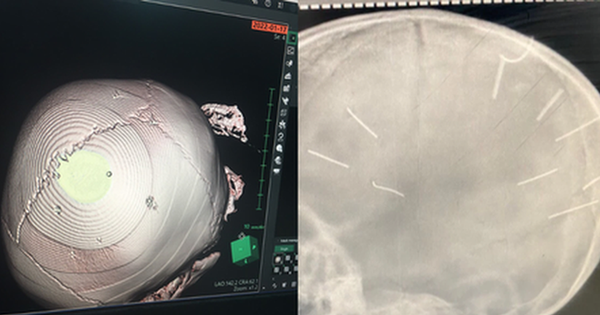Dong ThapThe enterprise proposes to build an industrial cluster, exploiting minerals near Tram Chim National Park, one of the nine world-recognized wetland conservation areas.
The 60-hectare industrial cluster, proposed by Ha Thanh Concrete Joint Stock Company, is located in Phu Hiep commune, Tam Nong district. More than a year earlier, at this location, the enterprise built a 25-hectare ceramic brick factory with a capacity of 15 million m2 of bricks per year, with a total investment of more than 1,000 billion VND.

The construction site of the industrial cluster (red) is located near A5, where the cranes live, in Tram Chim National Park. Graphics: Khanh Hoang
In addition to the proposed industrial cluster for brick and concrete production, on the opposite side of the factory, Ha Thanh Company was approved to explore and exploit clay mines to make bricks and tiles, with an area of nearly 10 hectares for rice cultivation. The project owner has completed the environmental impact assessment report awaiting approval and approval.
The proposed industrial cluster location is adjacent to the factory, extending towards Tram Chim National Park – the 2,000th Ramsar of the world, 7,500 hectares wide with 230 bird species, 130 fish species, 130 plant species. In particular, the national park in the West is where the red-crowned cranes have come to live for many years. Rare species of crane often feed in zone A5 of the national park, closest to the location of the industrial cluster.
Due to the ecological relationship of Tram Chim, as soon as there was a proposal to open an industrial cluster, the national park’s management board invited experts from the Mekong Delta Conservation Fund (MCF) and the Center for Environmental and Biological Sciences. (CESE) survey and impact assessment.
Dr. Duong Van Ni (MCF), who has studied conservation activities in Tram Chim for many years and is a member of the survey team, said that the location of the industrial cluster lies entirely in the buffer zone, away from the national park boundary. (zone A5) 300-700 m. This violated the provisions of the buffer zone of the Law on Biodiversity, dangerously affecting the Ramsar core area.
Dr. Ni also predicts the activities of the industrial cluster such as noise, which has strong physiological and behavioral impacts of birds; decrease in density, some species will have to move elsewhere. Industrial cluster emissions from the use of coal to burn bricks will emit sulfurous gases, affecting the habitat of birds and some plants due to acid rain.

Tram Chim National Park seen from above. Image: Ngoc Tai
The report of the surveying experts to the People’s Committee of Dong Thap province stated that wastewater from production, although the company has a plan to store and treat wastewater inside the industrial cluster, but the high terrain will cause water infiltration. . Worryingly, when the factory exploits all the clay layer, until the ancient alluvium layer is not able to waterproof, the leakage of wastewater into rivers and canals, penetrating deep into the underground aquifer is unavoidable.
According to Dr Ni, the reason Ramsar recognized Tram Chim National Park as the world’s 2,000th Ramsar site because the core and buffer zone here satisfy strict criteria in terms of environment, landscape and socio-economic conditions. association of people in the buffer zone.
Therefore, the development of industrial clusters in the buffer zone is contrary to previous commitments of the locality. “The risk of Ramsar organization will withdraw recognition for Tram Chim National Park”, he worries. In addition, experts believe that the term “industrial cluster” used here is not reasonable. Because all construction and operation items of an industrial cluster are actually just an expansion of a company’s activities.
The Dong Thap Provincial People’s Committee basically agreed to propose the establishment of an industrial cluster because it is suitable with the orientation of industrial development, contributing to creating jobs and income for local people. However, the government is also concerned that the proximity of the industrial cluster will affect the ecosystem of Tram Chim National Park.
Therefore, Dong Thap province has not yet agreed on the location of the industrial cluster proposed by enterprises. Provincial leaders assigned Tam Nong district administration to work with businesses to propose a plan to adjust the location of the industrial cluster to the border of Tan Hong district, avoiding affecting the environment of the national park. Up to now, the province has not made a final decision on the location of the industrial cluster.

A flock of red-headed cranes on their return to Tram Chim National Park in 2016. Photo: Nguyen Van Hung
Tram Chim National Park consists of 5 subdivisions, in which A1 and A5 are for tourism activities, A2 is a breeding ground for birds, A3 is for conservation of fish species, A5 is a main feeding ground for cranes – precious birds. in the Red Book. A few years ago the crane doesn’t come back Tram Chim, due to inappropriate management, human impacts on their feeding and living areas.
In addition to the core area of 5 subdivisions, Tram Chim also has a buffer zone of more than 16,800 ha, located around, in 5 communes of Phu Tho, Phu Thanh B, Phu Hiep, Phu Duc, Tan Cong Sinh and Tram Chim town. The buffer zone is considered to be a place to protect the core area of Ramsar site, which is in the management category of IUCN (International Union for Conservation of Nature and Natural Resources) to limit land use to reduce ecosystem resources.
Currently, Vietnam has 9 Ramsars recognized by the world. In the Mekong Delta, in addition to Tram Chim, there are Ca Mau Cape National Park, U Minh Thuong National Park (Kien Giang) and Lang Sen Wetland Reserve (Long An).
Ngoc Tai
at Blogtuan.info – Source: vnexpress.net – Read the original article here



